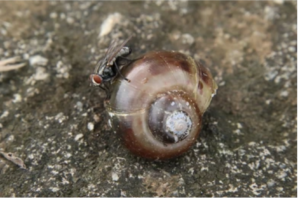Given our extensive knowledge about snails, including the indisputable fact that they lack legs, it is reasonable to presume that these legless creatures cannot jump. After all, how can any creature leap without legs?
Snails can jump, contrary to common belief. They can lift themselves off the ground using their muscular feet to avoid predators. This behavior is particularly observed in certain species, like the humpback conch. Even slugs exhibit this jumping behavior, highlighting a unique survival strategy.
Despite their bodies being designed primarily for crawling, snails jump their survival is at stake. This article delves into the scientific nuances of snail jumping, explaining why it garners significant interest in the scientific community.
Keep Jumping, Snails!
While compiling this article, I stumbled upon an intriguing video featuring a persistently jumping snail, available at the following link.
This captivating footage displays a snail simply living its life until the presence of a nearby predator prompts it to commence repeated leaps. The spectacle is astonishing and dispels any remaining doubts about the reality of jumping snails.
Understanding the Phenomenon: Why Do Snails Jump?
Several factors contribute to the astonishing phenomenon of snails jumping – some even achieving leaps as high as their body height.
Scientists have been studying the behavior of the humpback conch, a species notably residing in aquatic ecosystems. Garnering significant interest among researchers, it has been popularly dubbed the ‘jumping snail.’
The Humpback Conch: A Closer Look at the ‘Jumping Snail’
The white-shelled humpbacked conch snail prefers to inhabit sea environments, particularly coral reefs. This small snail, sporting a generally white shell and a humpback, lives under the sand close to the coral reefs.
It is one of the smaller members of the snail family, standing about 0.7 inches (1.8 centimeters) tall and measuring 1.5 inches (3.7 centimeters long).
Danger Lurks in the Reefs
Coral reefs may appear picturesque but are fraught with danger for the humpback conch. The ecosystem is home to perilous animals, such as the deadly cone-shelled snail that carries poisonous darts.
As the humpback conch roams through the water, it remains acutely aware of the threats posed by the cone-shelled snail. This predatory snail tends to emerge from the sand to launch its poison dart at the humpback, leaving it immobilized and ready to be consumed.
Survival Tactics: The Humpback’s Jump
Despite the predatory advantages of the cone-shelled snail, the humpback conch can evade capture, thanks to its heightened sense of smell.
While snails might lack keen eyesight, their olfactory senses are incredibly strong. Even the faintest scent of a predator triggers an immediate response in the humpback snail.
The humpback snail employs its muscular foot, powered by a significant oxygen intake, to rapidly lift its body off the ground, unmistakably resembling jumping.
The humpback aims to avoid the poisonous darts, hence their propensity to leap backward and as high as possible. Videos shared show how the snail repeatedly jumps in quick succession, propelling itself further away from its attacker.
Scientific Insight: The Jumping Study
Dr. Lefevre and his team of researchers at James Cook University in Australia conducted a study to decipher why the humpback conch is dubbed the jumping snail.
Using the odor of the cone snail, they found that the mere presence of this scent caused the humpback to leap, even in the absence of a physical threat.
The scent alone was enough to provoke the humpback into jumping, driven by instinct and the intense desire to avoid its identified predator.
Dr. Sue-Ann Watson of James Cook University humorously noted that while snails may not rival Olympic high jumpers, their leaping capabilities are still impressive for creatures lacking any kind of limbs.
The Leaping Semi-Slugs
Beyond the jumping humpback snails, another gastropod that’s earned the nickname of ‘jumping slug’ belongs to the genus Hemphillia. More accurately described as semi-slugs, these creatures are relatively rare and less commonly encountered in the wild than other snail species.
Hemphillia snails, native to the Pacific Northwest, are labeled semi-slugs for a good reason. Unlike other slugs that lack a shell, Hemphillia snails bear a characteristic yellow shell that protrudes through a small opening in their mantle. The petite shell, appearing as a hump on the slug’s back, safeguards the creature’s most vital organs.
Timothy A. Pearce recounted an engaging narrative about his encounter with a Hemphillia snail. During a forest walk, he stumbled upon these snails. He observed their unique behavior of vigorously flicking their tails, which caused them to shift from one side to the other.
Pearce further mentioned witnessing a semi-slug leap nearly 3 ft (a meter) off the ground. He also noted another instance where a semi-slug, startled by his approaching hand, elevated its body off a leaf, landed on the ground, and swiftly concealed itself in dense vegetation.
Survival Tactics: Why Do Semi-Slugs Jump?
Like the humpback conch snail, the semi-slug’s jumping is an instinctual response to perceived threats. However, Pearce suggests that these snails jump more as a means to deter predators rather than solely to escape them.
Nonetheless, the semi-slug’s leap away from an imminent predator and a reaching hand are compelling indicators of an animal’s adaptation to predation. Interestingly, it appears that slugs jump more frequently than their shelled counterparts.
While snails possess the natural defense of their hard shells, slugs lack this protective retreat in the face of predation. As such, their primary survival tactic involves launching themselves as high as possible to evade threats.
The Role of Slime in Snail and Slug Mobility
Undeniably, you might wonder how a snail or slug can manage a quick jump, lifting them off the ground, when their mobility primarily relies on a layer of sticky, mucus-like slime. Does this slime not confine them to a surface?
In actuality, a snail’s or slug’s slime is sticky, which becomes evident when they perform astonishing feats like crawling upside down in an aquarium or scaling steep walls without losing their grip.
However, the stickiness of the slime varies depending on the pressure exerted by the snail or slug. Thus, the slime doesn’t inhibit a snail or slug from jumping. Its stickiness diminishes once the creature relieves the pressure from its body, allowing it to spring off the ground effortlessly.
Summary
In this exploration, we have discovered that despite lacking legs, snails and slugs can jump, using their muscular feet to achieve this feat. Snails and slugs constantly navigate a world of threats, employing different survival strategies.
Shelled snails use their protective casing as a refuge. At the same time, shell-less slugs, among the slowest creatures, resort to jumping to escape predators.



